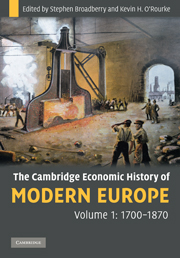7 - Industry
Published online by Cambridge University Press: 05 August 2012
Summary
The transition to modern economic growth occurred in Europe between the mid-eighteenth and mid-nineteenth centuries. The decisive breakthrough was made in Britain, and centered on the adoption of new technologies and methods of organization in industry. Although economic historians now see these changes as quite drawn out, building on already high shares of economic activity in industry, and involving only a modest increase in the growth rate before 1830, the term “Industrial Revolution” has continued to be widely used (Crafts, 1985a; Shaw-Taylor and Wrigley, 2008). As de Vries (2001) argues, the changes associated with industrialization were revolutionary in the sense that they proved to be irreversible and became an “ideal type,” like the French Revolution. Although the rest of Europe did not merely copy the British example – there were “different paths to the twentieth century” – the idea of “catching up” remains a useful starting point for thinking about continental industrial developments between the late eighteenth and the late nineteenth centuries (O'Brien and Keyder, 1978; Gerschenkron, 1962; Fremdling, 2000). Working at the pan-European level helps to make clear the fundamental significance of the Industrial Revolution for the history of mankind, something which can be lost when focusing on national developments.
Key themes
Technological progress
It is common in the literature on technological progress to make distinctions between invention, innovation, diffusion, and imitation (Mokyr, 1994, pp. 13–16). An invention is defined as a new discovery, while an innovation is the commercial application of an invention.
- Type
- Chapter
- Information
- The Cambridge Economic History of Modern Europe , pp. 164 - 186Publisher: Cambridge University PressPrint publication year: 2010
- 3
- Cited by

